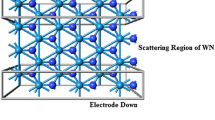Abstract
This work presents modeling and functioning of nanotube island single-electron transistor (SET), through first-principles approach based on density functional theory and non-equilibrium Green’s function. Ultrathin single-walled carbon (C), boron nitride (BN), and silicon carbide (SiC) nanotubes in armchair (3, 3) and zigzag (5, 0) structures have been adopted as island in the SET model. The nanotube (NT) islands are weakly coupled to gold metal electrode, explained by sequential transport phenomenon. Present study evaluates ionization energies, electron affinities, and additional energies for all the considered NTs in both isolated and SET environment, which are further analyzed by plotting total energies and Coulomb blockade diagrams. Also, various types of dielectric material and their thickness have been investigated, owing to measuring the stability of charge as well as dependence of conductance on gate and source-drain voltage. Observed results show noticeably enhanced conductance for ultrathin single-walled C, BN, and SiC zigzag NTs than that of their corresponding armchair NTs in the SET systems, demonstrating their potential for fast-switching device applications.








Similar content being viewed by others
REFERENCES
D. L. Klein, R. Roth, A. K. L. Lim, A. P. Alivisatos, and P. L. McEuen, Nature (London, U.K.) 389, 699 (1997).
J. Zhang, S. Liu, L. Kong, J. P. Nshimiyimana, X. Hu, X. Chi, P. Wu, J. Liu, W. Chu, and L. Sun, Adv. Electron. Mater. 4, 1700628 (2018).
K. Moth-Poulsen, Handbook of Single-Molecule Electronics (Pan Stanford, Singapore, 2016).
W. Liang, M. P. Shores, M. Bockrath, L. R. Long, and H. Park, Nature (London, U.K.) 417 (6890), 725 (2002).
S. Rani and S. J. Ray, Carbon 144, 235 (2019).
S. J. Ray, J. Appl. Phys. 118, 044307 (2015).
R. M. Lewis, C. T. Harris, and E. A. Shaner, and E. A. Shaner, AIP Adv. 8, 105317 (2018).
A. Kumar and D. Dubey, Adv. Electron. Electr. Eng. 3, 57 (2013).
Y. Wu, R. Zhao, C. Lu, and D. Guo, J. Comput. Electron. 19, 222 (2020).
M. F. L. de Volder, S. H. Tawfick, R. H. Baughman, and A. J. Hart, Science (Washington, DC, U. S.) 339 (6119), 535 (2013).
M. Ates, A. A. Eker, and B. Eker, J. Adhes. Sci. Technol. 31, 1977 (2017).
J. B. Casady and R. W. Johnson, Solid State Electron. 39, 1409 (1996).
D. Golberg, Y. Bando, Y. Huang, T. Terao, M. Mitome, C. Tang, and C. Zhi, ACS Nano 4, 2979 (2010).
M. Machon, S. Reich, C. Thomsen, D. Sanchez-Portal, and P. Ordejon, Phys. Rev. B 66, 155410 (2002).
Atomistix ToolKit-Virtual Nanolab (ATK-VNL), Quantum Wise Simulator, Version 2014.3. http://quantumwise.com/.
J. C. Riviere, Appl. Phys. Lett. 8, 172 (1996).
S. Parashar, P. Srivastava, and M. Pattanaik, Appl. Nanosci. 2, 385 (2012).
S. Parashar, P. Srivastava, and M. Pattanaik, IOP Conf. Ser. Mater. Sci. Eng. 73, 012117 (2015).
K. Stokbro, J. Phys. Chem. C 114, 20461 (2010).
S. K. Jain and P. Srivastava, Comput. Mater. Sci. 50, 3038 (2011).
J. Robertson, Eur. Phys. J. Appl. Phys. 28, 265 (2004).
ACKNOWLEDGMENTS
The author is thankful to Banasthali Vidyapith, Rajasthan, India, for the computational facilities.
Author information
Authors and Affiliations
Corresponding author
Ethics declarations
The author declares that he has no conflicts of interest.
Rights and permissions
About this article
Cite this article
Parashar, S. First-Principles Study of Ultrathin Single-Walled Nanotube-Based Single-Electron Transistor for Fast-Switching Applications. Phys. Solid State 62, 1807–1814 (2020). https://doi.org/10.1134/S1063783420100236
Received:
Revised:
Accepted:
Published:
Issue Date:
DOI: https://doi.org/10.1134/S1063783420100236




